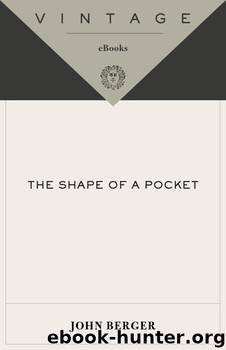The Shape of a Pocket by John Berger

Author:John Berger [Berger, John]
Language: eng
Format: epub, azw3
Published: 2013-09-17T16:00:00+00:00
Those who admire Antonioni’s films often say that he narrates like a novelist. Those who criticise his films often accuse them of being abstract, over-aesthetic, formalist. It seems to me that if one wants to enter the world of his imagination, one should first think of him as a painter. Human behaviour and stories interest him, but he begins with what somebody or somewhere looks like. His most important perceptions are pre-verbal. (This is perhaps why he can use silence so well.) Kieslowski, for example, is a real novelist of the cinema because he thinks about the consequence of actions. Antonioni gazes at the silhouette of an action, with all the painter’s desire to find in it something that is timeless. I would even go so far as to suggest he often forgets the consequence.
Since Antonioni exhibits as a painter, I’m not pointing out anything very original here. But if we go back to the Po and the Madonna of the Fog, and if we remember how he’s a painter, we discover, I think, a clue to his life’s work.
Antonioni’s films question the visible until there’s not enough light to see any more. The visible may be Monica Vitti or Marcello Mastroianni or a river bank or a ship’s hull or a tree or a tennis court. Unlike a true painter he can’t touch the image with his hands; he has to worry it in other ways – by lighting, by movement, by waiting, by a kind of cinematic stealth. His purpose is to make us peer into his films as one peers into the Po as it flows, as Monet peered into the depths of his water lily pond, as one walks peering through the fog.
The hope which, I believe, sustained him as he made each film, was that, as we peer, something will come to meet us, something that almost escaped him, something so real that it doesn’t have a name.
Halfway through Gente del Po a peasant on the river bank sharpens a scythe and a line of women, dressed in black, rake hay. One of the women straightens her back to gaze at the river as the barges pass. She is young. She is like nobody else. She has slightly protruding white teeth when she smiles. And she smiles, because whilst she gazes at the wide river with its colossal will to reach the sea, something comes out of it to meet her. We can read it on her face. But on the film we can’t see it.
Download
This site does not store any files on its server. We only index and link to content provided by other sites. Please contact the content providers to delete copyright contents if any and email us, we'll remove relevant links or contents immediately.
The Art of Boudoir Photography: How to Create Stunning Photographs of Women by Christa Meola(18538)
Red Sparrow by Jason Matthews(5391)
Harry Potter 02 & The Chamber Of Secrets (Illustrated) by J.K. Rowling(3624)
In a Sunburned Country by Bill Bryson(3486)
Drawing Cutting Edge Anatomy by Christopher Hart(3454)
Figure Drawing for Artists by Steve Huston(3384)
Harry Potter and the Prisoner of Azkaban (Book 3) by J. K. Rowling(3304)
The Daily Stoic by Holiday Ryan & Hanselman Stephen(3235)
Japanese Design by Patricia J. Graham(3112)
The Roots of Romanticism (Second Edition) by Berlin Isaiah Hardy Henry Gray John(2878)
Make Comics Like the Pros by Greg Pak(2854)
Stacked Decks by The Rotenberg Collection(2812)
Draw-A-Saurus by James Silvani(2656)
Harry Potter and the Deathly Hallows (7) by J.K. Rowling(2646)
Tattoo Art by Doralba Picerno(2600)
On Photography by Susan Sontag(2576)
Churchill by Paul Johnson(2506)
The Daily Stoic by Ryan Holiday & Stephen Hanselman(2461)
Drawing and Painting Birds by Tim Wootton(2438)
